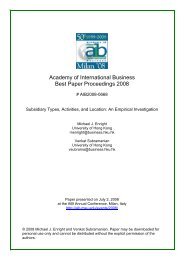AIB 2012 Conference Proceedings - Academy of International ...
AIB 2012 Conference Proceedings - Academy of International ...
AIB 2012 Conference Proceedings - Academy of International ...
Create successful ePaper yourself
Turn your PDF publications into a flip-book with our unique Google optimized e-Paper software.
SUNDAY<br />
able to develop, a complex set <strong>of</strong> macro-economic, institutional and managerial conditions requires attention.<br />
(For more information, please contact: Zita Stone, University <strong>of</strong> Kent, United Kingdom: z.stone@kent.ac.uk)<br />
<strong>International</strong>ization and Entrepreneurship: Empirical Evidence on the Regional Formation <strong>of</strong> New Ventures in<br />
China<br />
Julie Elston, Oregon State University<br />
Extensive market reforms targeted at increasing both internationalization and entrepreneurial activity over the<br />
last three decades in China have resulted in dynamic but uneven growth across regions. This study examines<br />
the importance <strong>of</strong> location on the empirical link between internationalization and firm formation across China.<br />
Results indicate that location significantly impacts firm formation, with rural China outpacing highly<br />
internationalized Shenzhen and Hong Kong regions in entrepreneurial activity. Empirical results suggest that<br />
higher degrees <strong>of</strong> regional internationalization are significant in predicting lower levels <strong>of</strong> entrepreneurial<br />
activity. From a policy perspective this suggests that reforms have been effective in stimulating entrepreneurial<br />
activity in the mainland China region which not only has a high rate <strong>of</strong> necessity-based entrepreneurship but an<br />
opportunity-based entrepreneurship rate more than double Hong Kong's. (For more information, please contact:<br />
Julie Elston, Oregon State University, USA: julie.elston@osucascades.edu)<br />
Rising Labour Disputes in China: Decoding <strong>of</strong> and Adapting to China's More Deamdning Labour Relations<br />
Audrey Heung Heung Tsui, National University <strong>of</strong> Singapore<br />
Roy Ee Jin Goh, National University <strong>of</strong> Singapore<br />
China witnessed in the past few years mounting outbreaks <strong>of</strong> labour disputes, strikes, protests and suicides,<br />
especially in the nation's coastal provinces that host many labour-intensive manufacturing investments. This<br />
involves, in particular, tens <strong>of</strong> thousands <strong>of</strong> migrant workers from inland China. Most export-oriented<br />
manufacturers, both local and foreign investments from Hong Kong and Taiwan, faced severe cash flow<br />
problem due to factory order cancellations in the global financial crisis. Many drastically retrench or closed<br />
shops as a consequence. In the bigger context, China's new aspirations <strong>of</strong> economic restructuring and<br />
industrial upgrading , and its determination to raise minimum wage, to strengthen union support, and to<br />
encourage arbitration and collective bargaining in settling disputes--all imply a tighter enforcement <strong>of</strong> laws to<br />
protect labour rights. The paper presents some guidelines for companies to read the signals <strong>of</strong> change and<br />
some action recommendations to address labour disputes by actively engaging relevant stakeholders.<br />
Harmonious labour relations will be one key driver for success for investors aspiring to have a long-term<br />
presence in the China market. (For more information, please contact: Audrey Heung Heung Tsui, National<br />
University <strong>of</strong> Singapore, Singapore: bizathh@nus.edu.sg)<br />
Cross-National Gender Differences in Micr<strong>of</strong>inance: Impact <strong>of</strong> Societal Trust and Other Characteristics<br />
Raj Aggarwal, University <strong>of</strong> Akron<br />
John W. Goodell, University <strong>of</strong> Akron<br />
Lauren Selleck, University <strong>of</strong> Akron<br />
In this paper we investigate the reasons why there is international variation in the extent to which women<br />
borrowers predominate with micr<strong>of</strong>inance institutions. Using a measure <strong>of</strong> social trust from the World Values<br />
Survey we find a negative association <strong>of</strong> the percent <strong>of</strong> women borrowers with social trust suggesting that a<br />
preference for women borrowers reflects compensation for a lack <strong>of</strong> social trust. Consistent with the social<br />
mission <strong>of</strong> micr<strong>of</strong>inance institutions, we find a positive association <strong>of</strong> the percent <strong>of</strong> female borrowers with the<br />
degree <strong>of</strong> "outreach" <strong>of</strong> the micr<strong>of</strong>inance institution, especially as this positive association is even stronger for<br />
nonpr<strong>of</strong>it micr<strong>of</strong>inance institutions and those that target the lower end <strong>of</strong> the social economic spectrum. We<br />
also find a negative association between the percent <strong>of</strong> female borrowers with the average loan size, and with<br />
the micr<strong>of</strong>inance institution being from Latin America. These results should be <strong>of</strong> great interest to policy makers<br />
<strong>AIB</strong> <strong>2012</strong> <strong>Conference</strong> <strong>Proceedings</strong><br />
Page 76

















